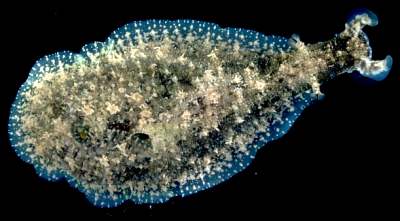
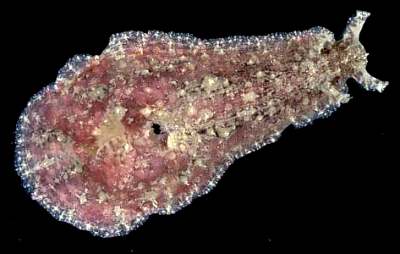
Dolabrifera dolabrifera
(Rang, 1828)
Order: ANASPIDEA
Family: Aplysiidae
DISTRIBUTION
Found circum-globally in warm tropical and sub-tropical waters.
PHOTO
Upper: North Coast of New South Wales, March, 1982. 34cm - semi-extended. AM C132999
Lower row: Koumac, New Caledonia, October, 1993. 38mm long. AM C200686. PHOTOS: Bill Rudman.
Dolabrifera dolabrifera is a relatively small flattened Sea Hare which grows to approx 10 cm in length. It is usually a mottled green or light brown but ranges in colour from pink to dark brown. The posterior half of the animal is usually broad and rounded gradually narrowing anteriorly to the head. The parapodia are fused except for a short region in the posterior midline, where two small flaps form and an inhalent and exhalent opening into the parapodial chamber which enloses the redued mantle cavity and shell. Although often described as smooth, it would seem that this species is covered in lower tubercles which bear retractile single or compound papillae. In preserved animals these papillae are seldom described presumably because they are retracted during preservation.
Note added 22 April 2010: The name Aplysia dolabrifera has usually been attributed to Cuvier, 1817 but that is a nomen nudum. It should be attributed to Rang, 1828. See discussion in message #23539.
See leech-like crawling
See egg ribbon & mating
See Dolabrifera brazieri page.
See Sea Hare shell page.
Reference:
• Bebbington, A. (1974) Aplysiid species from East Africa with notes on the Indian Ocean Aplysiomorpha (Gastropoda: Opisthobranchia). Zoological Journal of the Linnean Society, 54: 63-99.
• Bebbington, A (1977) Aplysiid species from Eastern Australia with notes on the Pacific Ocean Aplysiomorpha (Gastropoda: Opisthobranchia). Transactions of the Zoological Society of London, 34: 87-147.
• Cuvier, G.L. (1817) La Règne Animal. Vol. 2. (Gasteropodes), Vol. 4..
• Marcus, Ev. (1972) On the Anaspidea (Gastropoda: Opisthobranchia) of the warm waters of the western Atlantic. Bulletin of Marine Science, 22(4): 841-874.
• Ortea, J.A. & Martinez, E. (1991) El Orden Anaspidea (Mollusca: Opisthobranchia) en las Islas Canarias. Revista de la Academia Canaria de Ciencias, 3(4): 87-107.
Rudman, W.B., 2003 (April 26) Dolabrifera dolabrifera (Rang, 1828). [In] Sea Slug Forum. Australian Museum, Sydney. Available from http://www.seaslugforum.net/find/doladola
Related messages
Re: Dolabrifera dolabrifera from Aragua State, Venezuela?
April 30, 2010
From: Hans Bertsch
Concerning message #23539:
Greetings, Bill!
In your discussion of the authorship Dolabrifera dolabrifera, you may want to include the first report of this species from the eastern Pacific:
- Bertsch, H., 1970. Dolabrifera dolabrifera (Rang, 1828): Range extension to the eastern Pacific. The Veliger 13 (1): 110-111.
Sometimes we got lucky!
Cheers,
Hans
hansmarvida@sbcglobal.net
Bertsch, H., 2010 (Apr 30) Re: Dolabrifera dolabrifera from Aragua State, Venezuela?. [Message in] Sea Slug Forum. Australian Museum, Sydney. Available from http://www.seaslugforum.net/find/23568Thanks Hans,
Bill Rudman
Dolabrifera dolabrifera from Aragua State, Venezuela?
April 22, 2010
From: Neil J. Castro Guillén
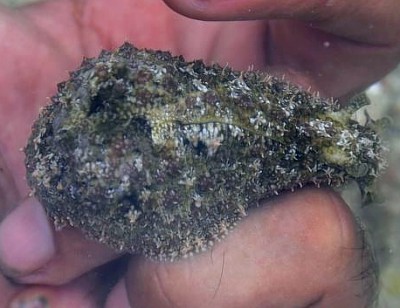
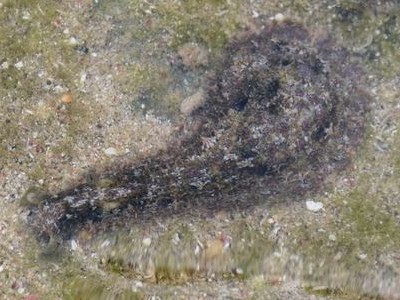
Dear Bill
We are writing in order to verifying the identity of this specimen. We think it is Dolabrifera dolabrifera (Opisthobranchia: Anaspidea: Aplysiidae) based on the resemblance to some animals discused on this forum. The sample we collected is somewhat flattened dorsoventrally and the body seems somewhat compact, with the body being narrower at the anterior end than the posterior one.
Although it is smooth when touched, many little pointed papillae can be seen all over the body of the live animal. When it died it was not possible to distinguish the papillae. Regarding the length of this sample it is a little bit longer than you reported on the Fact sheet of this species, reaching to aproximately 57 mm. Is there another record of a similar size?.
The rest of the body seems to be of the usual plan you have described.
We found this opistobranch on shallow waters at rocky shore bording the northern west side of La Ciénaga Lagoon, Aragua State, Venezuela, Caribbean Sea.
On the other hand, we have some questions regarding the taxonomy on this animal as there are some mismatches with the ITIS site information provided there:
http://www.itis.gov/servlet/SingleRpt/SingleRpt?search_topic=TSN&search_value=78049.
For instance on the family status and the authority of the species. Can you give us some clues?
Locality: Beach, 0,10, Aragua, Venezuela, Caribbean Sea, 17 April 2010, Rocky shore. Length: 57mm. Photographer: Neil Castro-Guillén.
Many thanks in advance
Kind regards
Neil Castro
Jaime Bolaños
neilbiologo@gmail.com
Castro-Guillén, N.J., Bolaños-Jiménez, J, 2010 (Apr 22) Dolabrifera dolabrifera from Aragua State, Venezuela?. [Message in] Sea Slug Forum. Australian Museum, Sydney. Available from http://www.seaslugforum.net/find/23539Dear Neil,
Firstly, although I try and keep the Fact Sheets up to date you should always treat the messages attached to each Fact Sheet as 'updates' to the Fact Sheet. There is a record of an 8 cm long animal in one message. Length in this species is quite difficult to be precise about because as your phtos show it can greatly extend its 'head and neck' as it crawls along. I will however change the Fact Sheet.
I was surprised to check the ITIS site and see Rang, 1828 listed as the author of the name and to the use of the family name Notarchidae and the common name warty sea cat.
Firstly the family name. Most authors consider the sea hares to belong to a single family Aplysiidae, and Klussmann-Kolb's (2004) recent work supports that opinion. As to the proposed 'common name' see my comments on the making up of so-called common names. As the common name for the aplysiidae is sea hares it seems a bit strange to call on a sea cat as well.
The most important question though is the author of the name Dolabrifera dolabrifera. I have always followed current usage which for at least 60 years as attributed the name to Cuvier, 1817 [for example see Ortea, J. A. & E. Martínez, 1990; Bebbington, A.,1974 and their extensive references]. However I checked Gary Rosenberg's Malacolog site for western Atlantic marine Mollusca [http://www.malacolog.org/index.html], because Gary is a meticulous examiner of nomenclatural correctness and I find that he considers Dolabrifera dolabrifera (Cuvier (1817, 2:398) is what we call a 'nude name' or nomen nudum. That means that although Cuvier used the name he gave no indication of any characters which could be used to identify the species. On checking Cuvier this is exactly the case, the name is mentioned in a footnote to the genus Dolabella but all he says is that it was found at the Isle de France. So it would seem the correct author of the name should be Rang, 1828. Rosenberg also notes that the largest reported size is 108 mm.
Although it does not affect the identity of the species correcting the authorship of the name is quite an important nomenclatural change. Thanks for drawing my attention to it.
- Bebbington, A. (1974). "Aplysiid species from East Africa with notes on the Indian Ocean Aplysiomorpha (Gastropoda: Opisthobranchia). Zoological Journal of the Linnean Society 54: 63-99.
- Cuvier, G. L. (1817). La Règne Animal, distribué d'après son organisation. Vol 2. Paris, Déterville.
- Klussmann-Kolb, A. (2004). "Phylogeny of the Aplysiidae (Gastropoda, Opisthobranchia) with new aspects of the evolution of the seahares." Zoologica Scripta 33(5): 439-462.
- Ortea, J. A. and E. Martínez (1990). "Moluscos Opistobranquios de Cabo Verde: Anaspidea (Aplysiomorpha)." Publicacoes Ocasionais da Sociedade Portuguesa de Malacologia 15: 17-42.
- Rang, S. (1828). Histoire naturelle des Aplysiens, première famille de l'ordre des Tectibranches: Histoire naturelle Génerale et particuliere des Mollusques. D. Férussac and D. Férussac. Paris, Firmin Didot: 84pp. Pls. 1-24.
Best wishes,
Bill Rudman
Dolabrifera dolabrifera found sthn Queensland
April 19, 2008
From: Gary Cobb
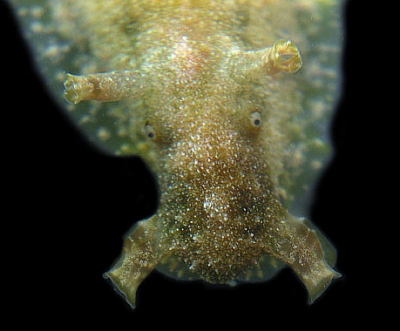
Hi Bill and everyone!
We went to Caloundra, Kings Beach boat ramp intertidal area and did some rock turning ... and out pops our 322nd species... Dolabrifera dolabrifera. Yet again we see another beautiful colour variation in the species. Notice this species has white and brown spots on it foot. Plus a face only a mother could love!
Locality: Sunshine Coast near Mooloolaba, 100 mm, Queensland, Australia, Pacific Ocean, 07 October 2007, Intertidal. Length: 43 mm. Photographer: Gary Cobb and David Mullins.
Cheers
Gary Cobb
gary@nudibranch.com.au
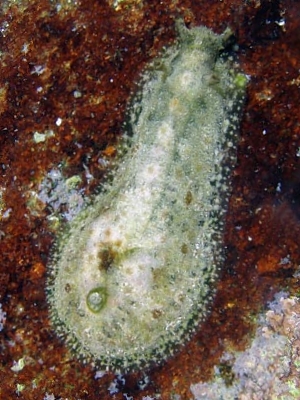
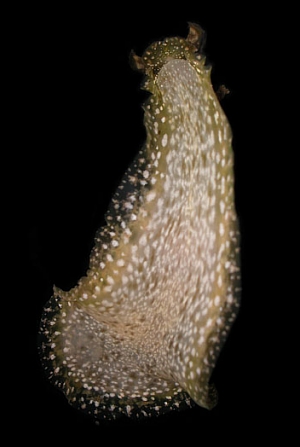
Thanks Gary,
Bill Rudman
Rudman, W.B., 2008 (Apr 19). Comment on Dolabrifera dolabrifera found sthn Queensland by Gary Cobb. [Message in] Sea Slug Forum. Australian Museum, Sydney. Available from http://www.seaslugforum.net/find/20915Pleurobranchus? from St. John, US Virgin Islands
July 24, 2007
From: Caroline S. Rogers
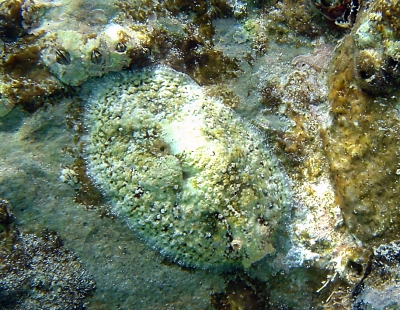
I photographed this sea slug yesterday. I am a coral reef ecologist and spend lots of time snorkeling, but I have never seen one of these before. Is it possibly Pleurobranchus atlanticus?
Locality: Francis Bay, St. John, 1 meter, United States Virgin Islands, United States of America, Caribbean, 21 July 2007, shallow boulders. Length: 4.4 cm. Photographer: Caroline S Rogers.
Thank you.
Caroline Rogers
csrstjohn@yahoo.com
Rogers, C.S., 2007 (Jul 24) Pleurobranchus? from St. John, US Virgin Islands. [Message in] Sea Slug Forum. Australian Museum, Sydney. Available from http://www.seaslugforum.net/find/20285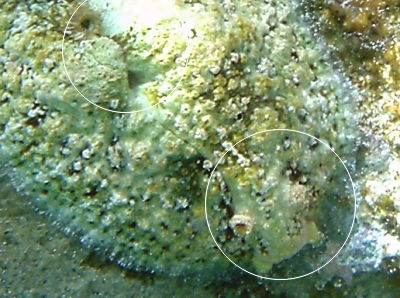
Dear Caroline,
This is a sea hare rather than a species of Pleurobranchus. In pleurobranchs [side-gilled slugs] the gill is on the right side of the body below the mantle flap. In this animal, which is much 'flatter' than most sea hares, the gill is hidden in the reduced mantle cavity beneath the small parapodial flap on the middle of the back [see upper ring]. It is Dolabrifera dolabrifera, a very well camouflaged species, with a flattened muscular body. This species is often found in shallow water, often in areas exposed to a lot of water movement - they can be thought of as the 'limpets' of the sea hare family. The shape of the head, rhinophores and oral tentacles [see lower ring] is typical of sea hares [see Sea Hare head Fact Sheet ].
Best wishes,
Bill Rudman
Dolabrifera dolabrifera from Canary Islands
August 23, 2006
From: Christian Kowalewski
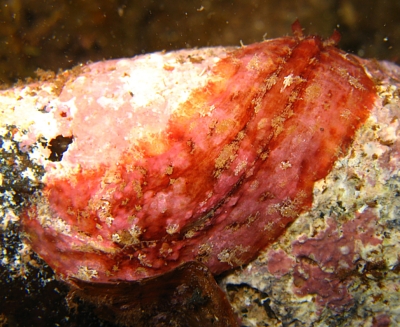
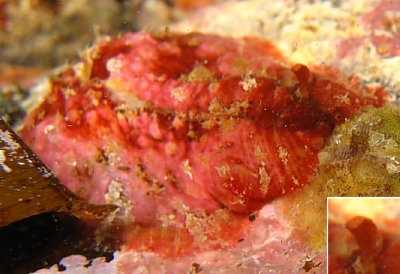
Dear Bill,
This was found in a rocky area near Cystoseira in Tenerife. We havent got any idea of what it is. There is a red and yellow one. I have a few other pictures of them but there were too many waves to stay longer there and I have only seen them once.
Locality: Tenerife Island, Canary Islands, 4 meters, Spain, Atlantic Ocean, 25 July 2006, On algal covered rocks. Photographer: Christian Kowalewksi
Thanks
Christian Kowalewski
moratorix@gmx.de
Kowalewski, C.J., 2006 (Aug 23) Dolabrifera dolabrifera from Canary Islands. [Message in] Sea Slug Forum. Australian Museum, Sydney. Available from http://www.seaslugforum.net/find/17579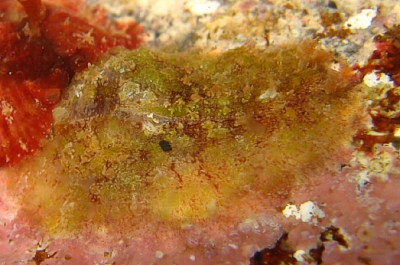
Dear Christian,
When I saw the photo of the reddish one my first thought was it was some sort of chiton, but your other photo showing the red and yellowish ones side on confirmed they are a species of Sea Hare. I am pretty sure they are Dolabrifera dolabrifera. This species has been reported from the Canary Islands (Ortea & Martinez, 1991), and can be very cryptically coloured
In your top photo the animal is very stretched out. Have a look at my earlier message [#9789] which described their very distinctive leech-like method of locomotion.
Ortea, J.A. & Martinez, E. (1991) El Orden Anaspidea (Mollusca: Opisthobranchia) en las Islas Canarias. Revista de la Academia Canaria de Ciencias, 3(4): 87-107.
Best wishes,
Bill Rudman
Dolabrifera dolabrifera from the Red Sea
March 10, 2005
From: Marina Poddubetskaia
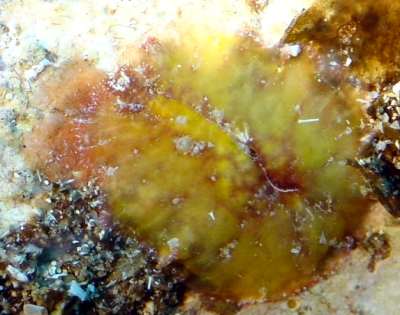
Dear Bill,
I'd like to have your opinion on this cryptic Sea Hare found in Dahab, Egypt. I would say it is Dolabrifera dolabrifera, but I'm not sure. Please, help me with this ID.
Locality: Caves, Dahab, Egypt, Red Sea. Depth: 7 m. Length: 15 mm. 03 March 2005. sandy, under stone. Photographer: Marina Poddubetskaia
Best wishes,
Marina.
Nembro website
nembro@nembro.info
Poddubetskaia, M., 2005 (Mar 10) Dolabrifera dolabrifera from the Red Sea. [Message in] Sea Slug Forum. Australian Museum, Sydney. Available from http://www.seaslugforum.net/find/13311Dear Marina,
It is certainly very cryptic. My best guess is that it is a form of Dolabrifera dolabrifera.
Best wishes,
Bill Rudman
Sea Hare from the Pacific coast of Panama
February 8, 2005
From: Rebecca Rissanen
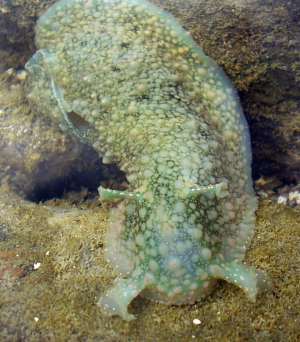
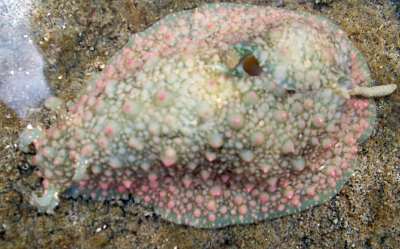
Hello!
This little fellow lives in the intertidal ponds of Punta Culebra, located on Naos island right by the Panama Canal entrance, in Panama. We've been having a little debate on his identity, and would greatly appreciate it if you could give us some insight, people here call them nudibranchs, but to me its a Sea Hare...
Locality: Punta Culebra, Naos. Panama, Rep. of Panama, Pacific coast. Depth: Tidepool, maximum 20 cm deep. Length: About 10 to 13 cm. 03 February 2005. Rocky intertidal zone, tidepools. Photographer: Rebecca Rissanen
Might be a silly question, but being accustomed to studying crabs, the knowledge on slugs is a bit limited for time being.
Thank you for a great site, by the way.
Rebecca
jaderr79@yahoo.com
Rissanen, J.R., 2005 (Feb 8) Sea Hare from the Pacific coast of Panama. [Message in] Sea Slug Forum. Australian Museum, Sydney. Available from http://www.seaslugforum.net/find/13084Dear Rebecca,
Some people use the word nudibranch to mean all sea slugs, but the nudibranchs are just one group of Sea Slugs. Your animal is indeed a Sea Hare, which are also sea slugs, but quite a different group. It is Dolabrifera dolabrifera which has a world-wide distribution in tropical and subtropical waters. If you have a look at some of the other messages on this species [listed below] you will see it is quite variable in colour. It is possible that the colour changes are associated with the colour of the algae they are eating but it needs to be studied.
Best wishes,
Bill Rudman
Dolabrifera dolabrifera from Little Cayman Island
January 29, 2005
From: Kathryn Dickson
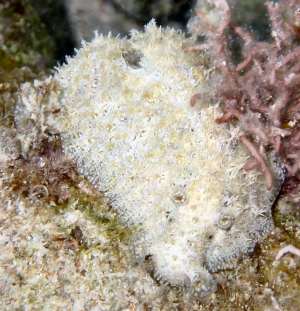
Hello Dr. Rudman
I discovered this nudibranch while snorkelling in Preston Bay, Little Cayman Island, in early December 2004. It was creamy in colour to very pale greenish, and the body was covered with ruffles. From the shape of its head I would have guessed that it belongs in the "sea hare" group, or perhaps a "doris", but I wasn't able to find it in Humann's field guide. I have looked through many of the photos posted on the sea slug forum, but didn't find anything at all similar. Can you help?
Locality: Preston Bay, Little Cayman Island, British Cayman Islands, Caribbean Sea. Depth: 2 feet. Length: 3-4 inches. early December 2004. very shallow protected inner reef. Photographer: Kathryn Dickson.
Thanks
Kathryn Dickson
Kathy.Dickson@ec.gc.ca
Dickson, Kathryn M., 2005 (Jan 29) Dolabrifera dolabrifera from Little Cayman Island. [Message in] Sea Slug Forum. Australian Museum, Sydney. Available from http://www.seaslugforum.net/find/12940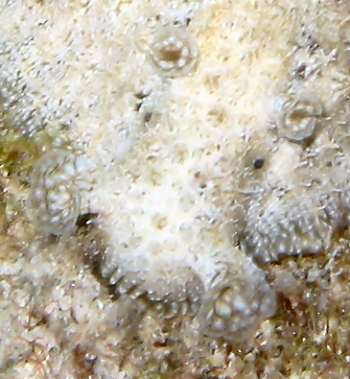
Dear Kathy,
This is a Sea Hare. I have added a close-up of the head which shows the characteristic features [see Sea Hare head Fact Sheet]. I am pretty sure this is a very white form of Dolabrifera dolabrifera. Usually this species has more green or brown colouration, but its colour is very bariable and its colour on the whole matches the background colour of its environment. Interestingly the larger Sea Hare, Aplysia dactylomela, often appears to be much whiter in the Caribbean than in the Indo-West Pacific. Perhaps the white coral sand is a more influential environmental factor in the Caribbean.
Best wishes,
Bill Rudman
Dolabrifera dolabrifera from the Caribbean
July 19, 2004
From: Bryan Thompson
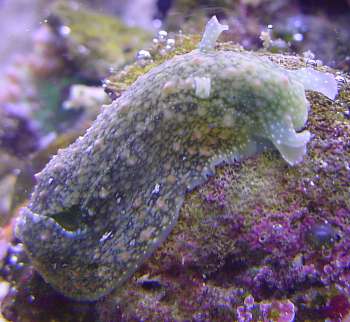
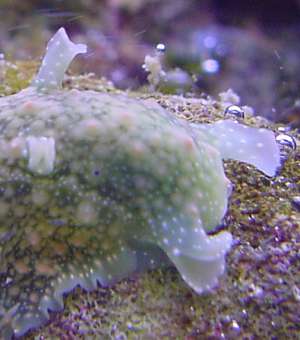
We just received about 20 of these awesome little guys. They are approximately 1". The come from the Caribbean. Can you give me a positive ID on them please?
Thank you,
Bryan Thompson
Blowfish Aquatics
bryan@blowfishaquatics.com
Thompson, B., 2004 (Jul 19) Dolabrifera dolabrifera from the Caribbean. [Message in] Sea Slug Forum. Australian Museum, Sydney. Available from http://www.seaslugforum.net/find/12618Dear Bryan,
I would say this is the Sea Hare Dolabrifera dolabrifera. The whitish line you can see running along the side of the body is the sperm groove which runs from the genital opening in the small mantle cavity at the back of the body, to the opening to the penis sac which is at the base of the right oral tentacle.
Best wishes
Bill Rudman
Dolabrifera dolabrifera from Colombia [Pacific coast]
November 20, 2003
From: N. E. Ardila
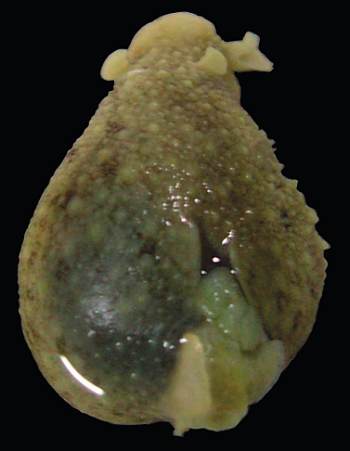
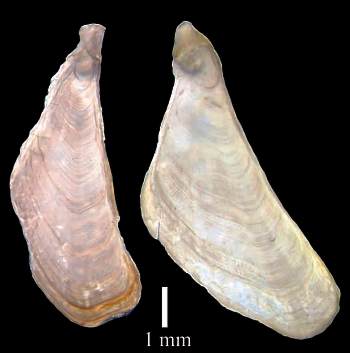
Dear Bill,
I send pictures of Dolabrifera dolabrifera collected in Cabo Corrientes, Colombia, [Eastern Pacific coast] in low tide on the rocks (2-3 m depth).
total length: 50 mm
shell length: 7-8 mm
Best wishes,
Nestor Ardila
Museo de Historia Natural Marina de Colombia
INVEMAR
nardila@invemar.org.co
Ardila, N.E., 2003 (Nov 20) Dolabrifera dolabrifera from Colombia [Pacific coast]. [Message in] Sea Slug Forum. Australian Museum, Sydney. Available from http://www.seaslugforum.net/find/11451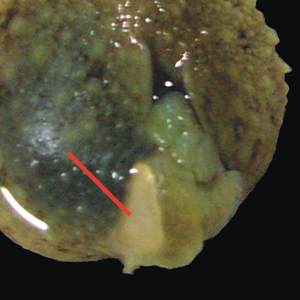
Thanks Nestor,
It's very interesting seeing photos of this widespread species from new localities. Thanks also for the photo of the shells. I have included a close-up alongside of part of one of your photos as it shows the position of the remnant shell inside the very reduced mantle flap.
Best wishes
Bill Rudman
Dolabrifera dolabrifera from Jamaica
October 12, 2003
From: Ross W. Gundersen
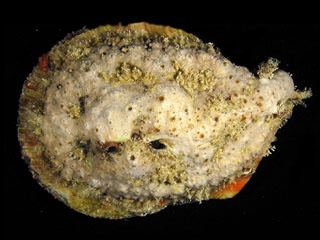
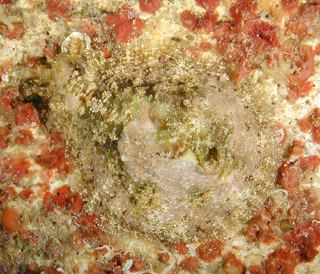
Dear Bill:
Here is another sea slug from Jamaica. As I said in my first message, all specimens were collected from St. Ann's Bay, Jamaica, West Indies. Photo: R. Gundersen.
Here is Dolabrifera dolabrifera. Found under coral rock at 1 m depth.
Best wishes,
Ross
ross.gundersen@uwp.edu
Gundersen, R.W., 2003 (Oct 12) Dolabrifera dolabrifera from Jamaica. [Message in] Sea Slug Forum. Australian Museum, Sydney. Available from http://www.seaslugforum.net/find/11114Thanks Ross,
This species shows an incredible variation in colour, apparently able to mimic the background colour with some amazing examples of camouflage
Best wishes
Bill Rudman
Dolabrifera dolabrifera from Christmas I., E. Kiribati
July 25, 2003
From: Don Barclay
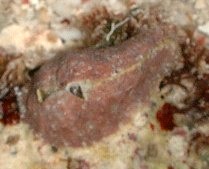
Hi Bill,
For the record, here is a typical photo of Dolabrifera dolabrifera from Christmas Island, Kiribati. My digital camera hates this species, and absolutely refuses to focus on them. They were common on the reef flat under slabs behind the Captain Cook hotel, and elsewhere.
Data: 20 May 2003, about noon, just after low tide, north side of Christmas Island, Line Islands, eastern Kiribati, behind Captain Cook hotel; under slab on reef flat, less than .5m of water; length about 60mm
Cheers,
Don
barclay@txucom.net
Barclay, D., 2003 (Jul 25) Dolabrifera dolabrifera from Christmas I., E. Kiribati. [Message in] Sea Slug Forum. Australian Museum, Sydney. Available from http://www.seaslugforum.net/find/10099Thanks Don,
Bill Rudman
Dolabrifera from aquarium
June 30, 2003
From: Oliver Hicks
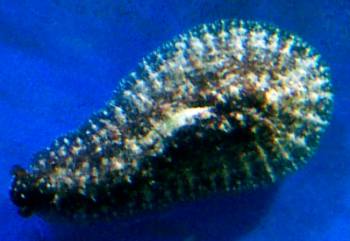
Hi everyone,
I was wondering, do any of you have an idea what type of sea slug this is, if indeed it is one at all? I'm pretty sure it is though, but I'm not the expert. :)
It was a hitch-hiker. I've been buying a few acroporas recently, so it may have come in with them. Or, it may have come in on my live rock, which comes from Indonesia.
Cheers,
Oliver
preds10@hotmail.com
Dear Oliver,
This is ae small tropical Sea Hare called Dolabrifera dolabrifera. It is almost certainly a live rock hitch hiker. It is a herbivore, so should be useful in keeping algal growth down
Cheers,
Bill Rudman
Dolabrifera dolabrifera from nthn New South Wales
April 26, 2003
From: Bill Rudman
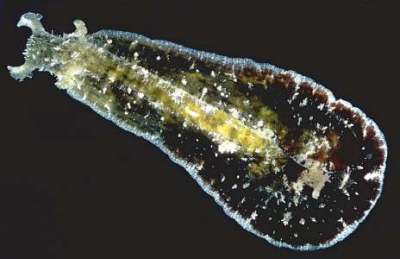
Here is a dark brown colour form of Dolabrifera dolabrifera from the north coast of New South Wales.
Angourie pool, North Coast, New South Wales, March 1982. 75mm -semi-extended length.
AM C132999. Photos: Bill Rudman
There are filaments, some branched, all over the body, including the oral tentacles and rhinophores.
Best wishes
Bill Rudman
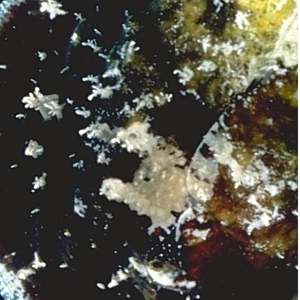
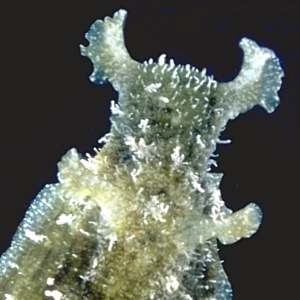
Dolabrifera dolabrifera from nthn New South Wales (2)
April 26, 2003
From: Bill Rudman
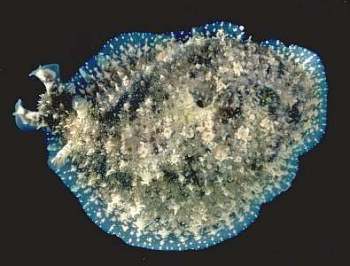
Here is another specimen of Dolabrifera dolabrifera from northern New South Wales.
Angourie pool, North Coast, NSW. Australia. March 1982. 34mm - semiextended length. AM C132999. Photos: Bill Rudman
This is a fairly typical mottled green and brown colour form. The photos show the single and compound papillae [or filaments] over the body and the head tentacles.
Best wishes
Bill Rudman
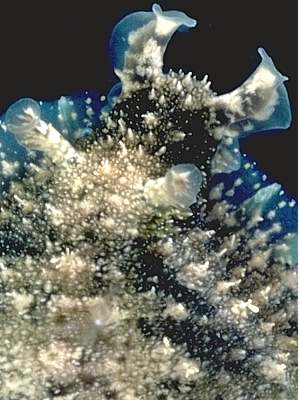
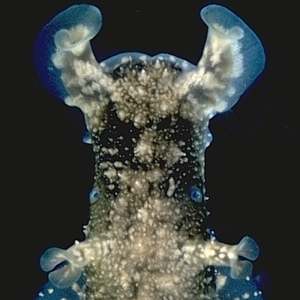
Dolabrifera dolabrifera from New Caledonia
April 26, 2003
From: Bill Rudman

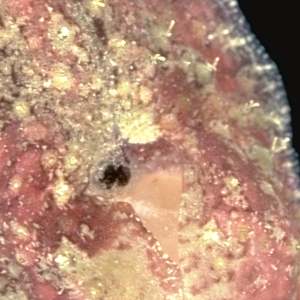
Here is a mottled pink and brown specimen of Dolabrifera dolabrifera from New Caledonia.
Lagoon between mainland & Récif de l'Infernet, 20°35.6'S, 164°15.2'E, 10-11m, off Koumac, New Caledonia, sand & grey mud, 28 October 1983, 38mm long alive, AM C200686. Photos: Bill Rudman
Like all Dolabrifera it was very cryptically coloured. The lower photo shows a few of the compound filaments on its mantle.
Best wishes
Bill Rudman
Locomotion in Dolabrifera dolabrifera
April 26, 2003
From: Bill Rudman
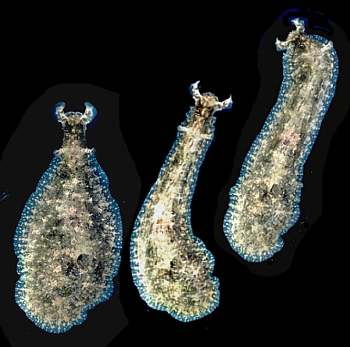
Species of Dolabrifera crawl with a very characteristic leech-like movement. Here are a sequence of photos of an animal showing this.
Angourie pool, North Coast, NSW. Australia. March 1982. 34mm - semiextended length. AM C132999. Photos: Bill Rudman
Dolabrifera is a very flattened Sea Hare with a very broad foot which enables it to stick firmly to the rocky substrate on which it lives. It could be considered a Sea Hare 'Limpet'. When crawling, the posterior end f the foot forms a posterior disc whih is firmly attached to the rock. At the same time the head is slightly raised off the rock and extends forward, the front part of the body stretching out to form a thin neck. When it stretches forward as far as it can, the head drops to the rock surface and attaches to it. Gradually the neck also attaches and gradually pulls the body forward - and the the proess is repeated again.
Best wishes,
Bill Rudman
My first sea slug
January 3, 2003
From: Stanisław Sitek
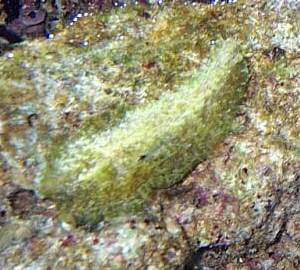
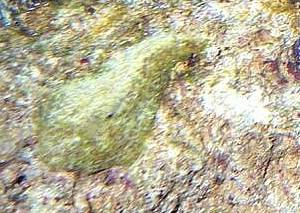
Here are some pictures of a snail which arrived on some live rock I got from Indonesia. It seems, that it feeds on algae growing over the rock. It is about 3cm. long. Could you tell me what it is please.
Stanisław Sitek
sts@inca.pl
Sitek, S., 2003 (Jan 3) My first sea slug. [Message in] Sea Slug Forum. Australian Museum, Sydney. Available from http://www.seaslugforum.net/find/8767Dear Stanisław,
I think your message is the first from Poland. Your 'hitch-hiker' is Dolabrifera dolabrifera. If you look through the other messages on this page you will see it seems to survive quite well on 'live rock'. It is a type of Sea Hare, and like all its relatives, it feeds on algae. It should be quite happy living in your aquarium, as long as there is some green algae for it to graze on.
Best wishes,
Bill Rudman
Live rock hitchhiker - Dolabrifera
October 3, 2002
From: Peter Lau
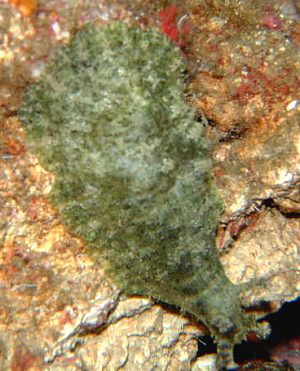
I am a beginner reef aquarium keeper. I have just purchased a bunch of Fiji live rocks and found a green, slug-looking animal hitch hiked on one of the rocks. It is approx. 2 inches long and 1 inches wide at its widest (toward the rear-end of this animal). It has four antennae-looking things sticking out from its head. It has a rather flat body and very flexible and fluid, which allows it to slide from one rock to another. It has been eating mostly the hair algae on the live rocks and seem to prefer to stay on the two uppermost rocks in the tank (closer to the light?). Someone on another website had suggested that this is a lettuce nudibranch but from every photo that I can find of a lettuce nudibranch, this thing looks nothing like it. For one thing, it does not have a ruffled body, it is rather flat with little antennae-like things sticking up. Can someone help me identify it and provide its requirements, particularly its diet so that I am sure that it will not eat any corals that I buy in the future.
Thanks so much,
Peter
peter.lau@verizon.com
Lau, P., 2002 (Oct 3) Live rock hitchhiker - Dolabrifera. [Message in] Sea Slug Forum. Australian Museum, Sydney. Available from http://www.seaslugforum.net/find/7971Dear Peter,
This is a little Sea Hare called Dolabrifera dolabrifera. Have a look at the Fact Sheet, and other messages attached to that page, for further information. Like all Sea Hares it is a herbivore so no danger to your corals. It doesn't grow very big and it could be useful in grazing algal films which grow on the aquarium glass.
Best wishes,
Bill Rudman
Dolabrifera dolabrifera? from Japan
July 20, 2002
From: Nishina Masayoshi
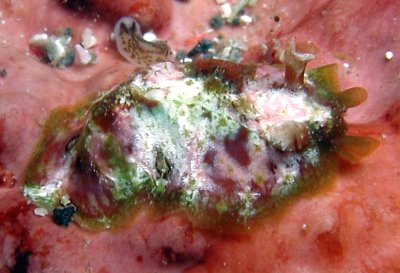
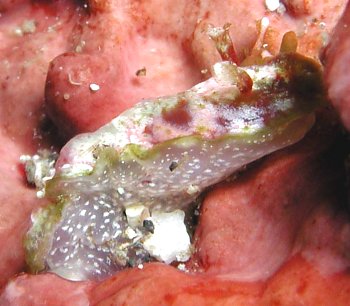
Dear Bill,
I suspect this is Dolabrifera dolabrifera or similar species. I moved the animal to take a photo but this animal was well camouflaged in the rock covered with moss at the orginal place.
Date: 2002 April 21
Location:Hachijo Island Japan
Depth: 6m
Length: 8mm
Photo by N.Masayoshi
Best Regards,
Nishina Masayoshi
nishina@wips.co.jp
Masayoshi, N., 2002 (Jul 20) Dolabrifera dolabrifera? from Japan. [Message in] Sea Slug Forum. Australian Museum, Sydney. Available from http://www.seaslugforum.net/find/6834Dear Nishina,
Yes I am pretty sure this is Dolabrifera dolabrifera. I have seen some strange looking specimens with quite smooth skins, which seem to be mimicking their background. It is always possible there are more species, but until we get more information I will leave it with more typical D. dolabrifera
Best wishes,
Bill Rudman
Re: Petalifera? sp. from Bahia de Banderas
July 4, 2002
From: Alicia Hermosillo
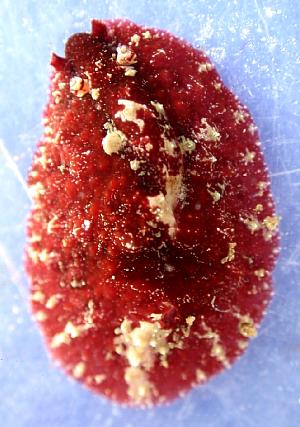
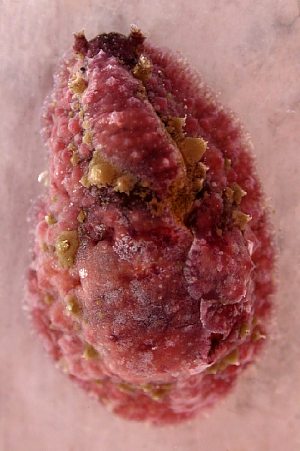
Dear Dr. Rudman,
I wish I could tell you what makes me think that this animal is not Dolabrifera dolabrifera but a Petalifera ... it is just different enough. This picture I sent I took it when taxonomist Sandra Millen was diving here, and we both looked at it over and over and it did not seem to be D. dolabrifera. I guess we should do some dissecting to be sure but you are probably correct. I let you know if I find more.
This picture is of a Dolabrifera dolabrifera like the ones I see around, the vary from pink, brown and red. This one is 21mm long, 15 feet deep from Mismaloya, Bahia de Banderas, Pacific Coast of Mexico, May 9th. (The pink one is from 17 feet deep and is 18mm long, same day and location)
Ali
gueri25@hotmail.com
Hermosillo, A., 2002 (Jul 4) Re: Petalifera? sp. from Bahia de Banderas. [Message in] Sea Slug Forum. Australian Museum, Sydney. Available from http://www.seaslugforum.net/find/7396Dear Ali,
I know that feeling well. It can be very frustrating to have that 'feeling' that something's different but be unable to quantify it or put it in words. My only advice is to persevere, it may take a year or more, but if you are lucky you'll find the answer. Looking at your lower photo, the animal seems to have papillae all over its back just like the earlier animal. On some of the rounded tubercles you can see short thin papillae. These are almost certainly retracted branching papillae. Although these animals seem tough, the papillae can be very sensitive to disturbance and can takes hours bfore the papillae fully expand -especially when you want to photograph them.
Good Luck,
Bill Rudman
Petalifera? sp. from Bahia de Banderas
June 28, 2002
From: Alicia Hermosillo
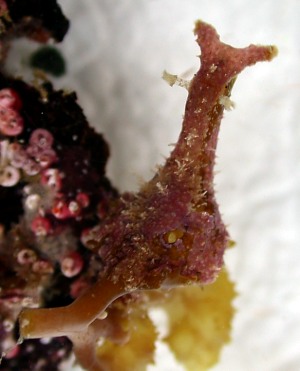
Dear Dr. Rudman,
I found this species of Petalifera? I have not been able to positively identify. I looks remarkably like the Dolabrifera dolabrifera I find here all the time, but it is not. This animal was moving fast, going from alga to alga (the ones you see in the picture) but it did not look to be eating it. Can you give me any light on this?
Photo: Islas Marietas, Bahia de Banderas, Pacific Coast of Mexico. 25 feet deep, 13mm long.
Alicia Hermosillo
gueri25@hotmail.com
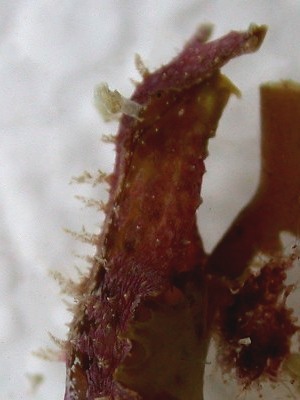
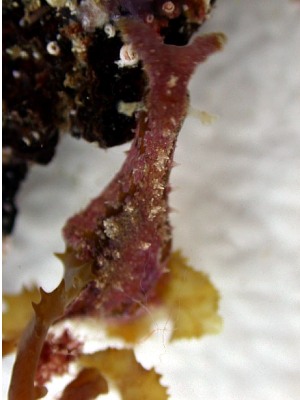
Dear Alicia,
I am afraid much of the taxomonmy of sea hares has been done on preserved animals so the 'experts' realy knew nothing of th shape of the living animals. I am interested in your comment that it is not Dolabrifera dolabrifera as that would have been my first suggestion. Dolabrifera chnages shape very easily and when crawling on a flat surface appears much flatter than when it is moving amongst narrow branches as in your photo. I would be intereted in knowing what differences you have noticed. It is always possible that you have a new species, but if you do I suspect it will a Dolabrifera not a Petalifera. In the meantime I'll 'file' this message on the Dolabrifera dolabrifera page.
Best wishes,
Bill Rudman.
Re: Dolabrifera?
April 17, 2002
From: Vick
Dr. Rudman,
Yes, I did find it in my aquarium, it has been quite active lately. Thank you for the identification!
Vick
vtagawa@ieee.org
Vick, 2002 (Apr 17) Re: Dolabrifera?. [Message in] Sea Slug Forum. Australian Museum, Sydney. Available from http://www.seaslugforum.net/find/6751Dolabrifera?
April 15, 2002
From: Vick
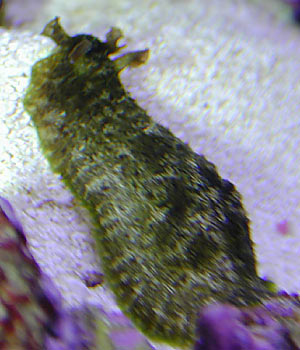
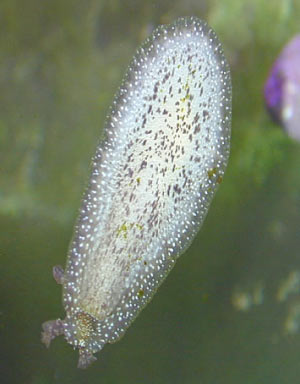
Hello All,
I just found your Forum. Can you help me identify this little guy? Sorry about the blur, he was on the move today.
Thanks!
Vick
vtagawa@ieee.org
Vick, 2002 (Apr 15) Dolabrifera?. [Message in] Sea Slug Forum. Australian Museum, Sydney. Available from http://www.seaslugforum.net/find/6649Dear Vick,
I guess you found it in your Aquarium? It is definitely a Sea Hare, and most probably Dolabrifera dolabrifera, which seems quite able to hitch a ride on stray bits of 'live rock'. It should be happy in your aquarium, and make you happy, by grazing on green algae growing on rocks and the glass.
Best wishes,
Bill Rudman.
Dolabrifera references?
April 15, 2002
From: Shallin Busch
Hi everyone-
I am a graduate student in zoology at the University of Washington, and am working on a side project on Dolabrifera dolabrifera. I got involved with the species while on an Organization for Tropical Studies field course in Cabo Blanco Reserve in Costa Rica, where a students have been collecting ecological and behavioral data on D. dolabrifera for a few years. I am trying to collect all of our results for a manuscript, and am now having problems finding primary literature on D. dolabrifera in the wild or even under natural settings in the lab. It would be great if anyone who is more knowledgeable with this area of the literature could give me some leads.
Thanks!
Shallin Busch
shallin@u.washington.edu
Busch, S., 2002 (Apr 15) Dolabrifera references?. [Message in] Sea Slug Forum. Australian Museum, Sydney. Available from http://www.seaslugforum.net/find/6722Dear Shallin,
Although there a quite a few references to the anatomy of Dolabrifera I am afraid I don't know of any publications on the ecology or life history of this species. If anyone is aware of any could they please let us know.
Best wishes,
Bill Rudman
Help ID Sea Hare
December 21, 2001
From: Brad Janecka
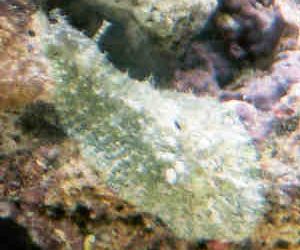
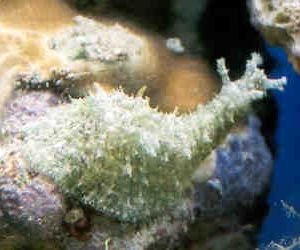
I recently found this Sea Hare in my 75 gal. reef tank. I am assuming he came along with some fiji rock that I used for building my reef. He is about 1 1/2 inches long and can stretch his neck even further. I am concerned with the "ink" that they can release when threatened. Will this "ink" kill something or everything in my tank? What happens when the sea hare dies? Is the "ink" released or can the "ink" be released as the body decomposes if I can not find it inside the tank? Should I avoid certain fish or other items that would harass him and increase the likelyhood of "inking"?
Thanks for your help.
Brad Janecka
bradj@southwestrec.com
Janecka, B., 2001 (Dec 21) Help ID Sea Hare. [Message in] Sea Slug Forum. Australian Museum, Sydney. Available from http://www.seaslugforum.net/find/5856Dear Brad,
Your Sea Hare is Dolabrifera dolabrifera. As you will see at the top of the page, stretching out its 'neck' to crawl along is quite characteristic of Dolabella. Sea Hares seem to co-exist in aquaria quite well so I can't imagine to much drama. This species only grows about as big as your animal so I don't think 'inking', if it occurs, will foul your tank. In some species that have been studied purple ink is only produced when Sea Hares eat red algae. I suspect in your tank it will be eating greens so again inking will probably not be a problem.
Best wishes,
Bill Rudman.
Dolabrifera dolabrifera mating
October 11, 2001
From: Scott Johnson
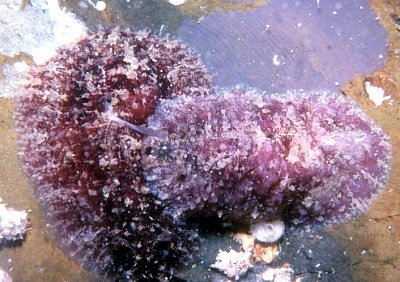
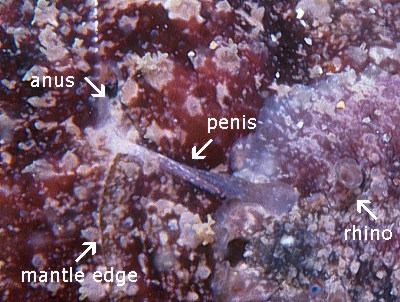
Hi Bill,
Here is a shot of a pair of Dolabrifera dolabrifera, a common species on intertidal and shallow subtidal reefs. It appears that the animals are mating. The egg mass at upper right has a bit more of a purplish tinge than I usually see. This shot was taken in Hawaii in the late 70s. I included blow ups of the eggs and mating.
Scott
johnson@kmr.ll.mit.edu
Johnson, S., 2001 (Oct 11) Dolabrifera dolabrifera mating. [Message in] Sea Slug Forum. Australian Museum, Sydney. Available from http://www.seaslugforum.net/find/5422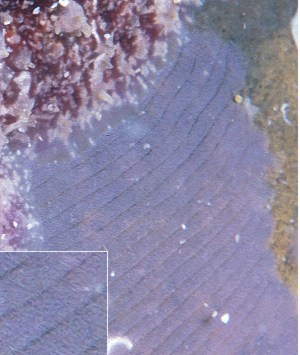
Dear Scott,
Thanks for the photos of the mating animals and the egg mass which I have attached alongside my comments.
I'm sure your animals are mating. To help those not sure what is happening, in the upper photo the animal on the right has its penis extended into the mantle cavity of the other animal [which has its head at the bottom of the photo]. In Dolabrifera the mantle cavity is very reduced and the parapodia are just small flaps of skin. The genital opening is a pore at the anterior end of the mantle cavity and the anus opens on a small papilla at the posterior end. In this photo the penis has entered the mantle cavity at the posterior end (by the anus) but I assume it can reach the genital pore which is only a short distance forward.
As Scott's photo of the egg mass shows so well, Dolabrifera is, I think, unique amongst the sea hares in having its egg mass attached long one edge, rather than in a tangled mass.
Best wishes,
Bill Rudman
Dolabrifera from Colombia
October 9, 2000
From: Phanor Montoya
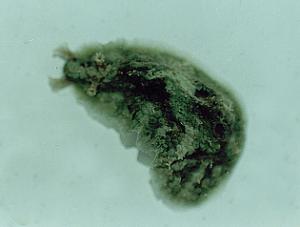
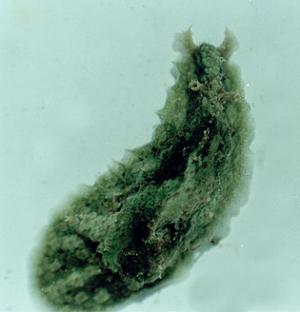
Dear Bill:
I think this aplysiid is Aplysia cervina? But I'm not sure. It was collected under rocks from Santa Marta, Colombia. The rinophores are cylindrical. The body is green with some kind of greenish warts brown tipped.
Thanks again.
Phanor Montoya
phamont@eudoramail.com
Monyoya, P., 2000 (Oct 9) Dolabrifera from Colombia. [Message in] Sea Slug Forum. Australian Museum, Sydney. Available from http://www.seaslugforum.net/find/3126Dear Phanor,
This is Dolabrifera dolabrifera which is found throughout the tropical Indo-West Pacific as well as the Caribbean.
It is much more flattened than a typical Aplysia and there are no large parapodia flaps. One thing you may find if Dolabrifera is around is its egg mass. Unlike the tangled mass of most Sea Hares, illustrated in your earlier message, the egg mass of Dolabrifera is flattened on to a rock or other hard surface. It is doesn't form a spiral but a tightly packed zig-zag pattern.
Best wishes,
Bill Rudman.
Re:Re: Want to know what it is..
November 7, 1999
From: Stephane
Yes, I think this is my guy! ;-) And Hopefully, it eats algae. So I'll keep it in my tank (I removed it temporarly in my decantation tank).
Thank you for your help.
Regards,
Stephane
s.tardy@freesurf.fr
Re: Want to know what it is..
November 6, 1999
From: Stephane
Hello,
Thanks for your answer,
My live rocks cames from Madagascar. I have them for 6 weeks. I've just discovered the slug 4 days ago...
I had a look at your photo of Dolabrifera dolabrifera, and yes! It seems to be that : the shape is very near of it, but the color is not the same, it is less spotted.
Thanks,
Stephane
s.tardy@freesurf.fr
Tardy, S., 1999 (Nov 6) Re: Want to know what it is... [Message in] Sea Slug Forum. Australian Museum, Sydney. Available from http://www.seaslugforum.net/find/1490Dear Stephane,
Dolabrifera has quite a range of colour, so I guess that's what you have. It is a herbivore, so I suspect it will find enough on the rock in your tank to feed itself. It may even be useful in cleaning algal growth of the glass.
Bill Rudman.
Want to know what it is...
November 5, 1999
From: Stephane
Hello,
I've discovered a big slug in my reef tank (certainly from my living rocks...). I want to know if it eats algae or meat... If someone can help me. Here is the description:
it is about 7cm long, 3cm width. The color is beige and the limits around are green. There is nothing on its back, just a little hole on its middle back (on top). There are 4 feelers on the front (two little below and two longer above).
Regards,
Stephane
s.tardy@freesurf.fr
Tardy, S., 1999 (Nov 5) Want to know what it is.... [Message in] Sea Slug Forum. Australian Museum, Sydney. Available from http://www.seaslugforum.net/find/1488Dear Stephane,
I'm afraid you don't give me many clues. Perhaps it is a Sea Hare. Have a look at the page on Sea Hares and look at the other pages on Sea Hares listed in the General Topics Index. Perhaps it is Dolabrifera dolabrifera
If it doesn't look like a Sea Hare then I think you will need to send me a photo or a drawing of your slug. Have you any idea where the 'live rock' came from? How long have you had it? If the slug has grown in your aquarium to 7cm then perhaps it has found some food to eat.
Sorry I can't say much more without some more information.
Best wishes,
Bill Rudman.
